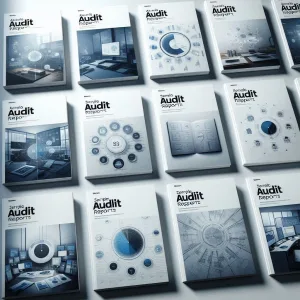In the realm of internal auditing, understanding Information Technology General Controls (ITGC) and their relationship with the Sarbanes-Oxley Act (SOX) is crucial for ensuring compliance and enhancing corporate governance. This section aims to provide a foundational understanding of these concepts, which are essential for internal auditors and audit managers.
Information Technology General Controls (ITGC) are the foundational controls that govern the IT environment supporting financial reporting systems. These controls ensure the integrity, accuracy, and completeness of data processed by IT applications. ITGC encompasses various aspects, including:
- Access Controls: Ensuring that only authorized personnel can access sensitive financial data.
- Change Management: Managing changes to IT systems and applications to prevent unauthorized alterations.
- Data Backup and Recovery: Safeguarding data through regular backups and having recovery plans in place in case of data loss.
The role of ITGC within the SOX framework is to provide a reliable environment for financial reporting, thereby protecting investors from fraudulent activities and ensuring that financial statements are accurate and trustworthy [1][11].
The Sarbanes-Oxley Act, enacted in 2002, was a response to major corporate scandals that highlighted the need for improved corporate governance and accountability. SOX aims to enhance the accuracy and reliability of corporate disclosures and financial reporting. Key provisions of SOX include:
- Increased Accountability: Corporate executives are required to certify the accuracy of financial statements, which holds them accountable for any discrepancies.
- Enhanced Internal Controls: Companies must establish and maintain effective internal controls over financial reporting, which includes ITGC as a critical component.
- Independent Audits: SOX mandates that external auditors assess the effectiveness of internal controls, including ITGC, thereby providing an additional layer of scrutiny [1][8].
By enforcing these measures, SOX significantly contributes to restoring investor confidence and promoting ethical business practices.
The relationship between ITGC and overall SOX compliance is integral to the success of an organization’s internal control framework. Effective ITGC ensures that the systems and processes that support financial reporting are secure and reliable. This relationship can be outlined as follows:
- Foundation for Application Controls: ITGC serves as the groundwork for application controls, which are specific to financial reporting processes. Weaknesses in ITGC can lead to vulnerabilities in application controls, potentially compromising financial data integrity [4][11].
- Risk Assessment: Organizations must conduct risk assessments that include evaluating ITGC to identify potential weaknesses that could impact financial reporting. This proactive approach is essential for effective SOX compliance [5].
- Audit Integration: ITGC audits should be integrated into the overall audit process, allowing auditors to assess the effectiveness of these controls early in the planning phase. This integration helps ensure that any identified weaknesses are addressed before they can affect financial reporting [4][10].
A solid understanding of ITGC and their role within the SOX framework is vital for internal auditors. By recognizing the significance of these controls and their relationship to SOX compliance, auditors can better assess risks and enhance the effectiveness of their audit processes.
Understanding the Key Components of ITGC
In the realm of internal auditing, particularly concerning the Sarbanes-Oxley Act (SOX), understanding Information Technology General Controls (ITGC) is crucial for ensuring compliance and safeguarding the integrity of financial data. Internal auditors and audit managers must focus on several key components of ITGC to effectively assess compliance and mitigate risks. Below are the main areas of ITGC, their significance, and the potential consequences of weaknesses in these controls.
Main Areas of ITGC
- Access Controls: Access controls are essential for preventing unauthorized access to financial data and systems. They ensure that only authorized personnel can view or modify sensitive information, thereby protecting the integrity of financial reporting. Effective access controls include user authentication, role-based access, and regular reviews of user permissions.
- Change Management: Change management processes are critical for overseeing modifications to IT systems and applications that handle financial data. This component ensures that changes are made in a controlled manner, with proper documentation and approval processes in place. A robust change management system helps prevent unauthorized alterations that could compromise data integrity.
- Operations Controls: Operations controls encompass the procedures and policies that govern the day-to-day functioning of IT systems. This includes monitoring system performance, ensuring operational continuity, and managing incidents. Effective operations controls are vital for maintaining the reliability of financial data processing and reporting.
- Backup and Recovery Procedures: Backup and recovery procedures are crucial for data protection and business continuity. These controls ensure that financial data can be restored in the event of a system failure or data loss. Regular testing of backup systems and recovery plans is necessary to confirm their effectiveness and readiness in a crisis.
Importance of Each Component
- Supporting Financial Data Integrity: Each component of ITGC plays a pivotal role in maintaining the accuracy, completeness, and reliability of financial data. For instance, access controls prevent unauthorized changes, while change management ensures that all modifications are documented and approved, thereby reducing the risk of errors or fraud.
- Compliance Assurance: Strong ITGC not only supports the integrity of financial reporting but also helps organizations comply with SOX requirements. By establishing effective controls, organizations can demonstrate to auditors that they have taken the necessary steps to protect financial data.
Consequences of Weaknesses in ITGC
- Increased Risk of Compliance Issues: Weaknesses in any of the ITGC components can lead to significant compliance challenges. For example, inadequate access controls may allow unauthorized users to manipulate financial data, resulting in inaccurate reporting and potential legal repercussions.
- Potential for Fraud and Errors: Insufficient change management processes can lead to unauthorized changes in financial systems, increasing the risk of fraud or unintentional errors. This not only jeopardizes the integrity of financial data but can also damage an organization’s reputation.
- Operational Disruptions: Poorly managed operations controls can result in system outages or failures, disrupting financial reporting processes. This can lead to delays in financial disclosures and erode stakeholder confidence.
Internal auditors must prioritize the assessment of these key components of ITGC to ensure compliance with SOX and protect the integrity of financial data. By employing effective auditing techniques and addressing potential weaknesses, organizations can enhance their internal controls and mitigate risks associated with financial reporting.
Planning the ITGC SOX Audit
Effective planning is crucial for internal auditors and audit managers when conducting IT General Controls (ITGC) audits for Sarbanes-Oxley (SOX) compliance. A well-structured audit plan not only ensures compliance but also enhances the overall integrity of financial reporting. Here are key points to consider when planning your ITGC SOX audit:
Adopt a Risk-Based Approach: Utilizing a risk-based approach is essential in planning ITGC audits. This method allows auditors to focus on areas with the highest risk of material misstatement, ensuring that resources are allocated efficiently. By identifying and prioritizing risks, auditors can tailor their audit procedures to address the most significant threats to financial reporting integrity [6][10].
Assess the IT Environment: A thorough assessment of the IT environment is necessary to identify high-risk areas. This involves evaluating the organization’s IT infrastructure, applications, and processes to determine where vulnerabilities may exist. Key factors to consider include:
- The complexity of the IT systems in use.
- The volume and sensitivity of data processed.
- Historical incidents of control failures or breaches.
Developing an Audit Plan and Timeline: Once high-risk areas are identified, the next step is to develop a comprehensive audit plan. This plan should include:
- Objectives: Clearly define what the audit aims to achieve, focusing on compliance with SOX requirements.
- Scope: Determine the boundaries of the audit, including which systems, processes, and controls will be evaluated.
- Methodology: Outline the techniques and tools that will be used during the audit, such as interviews, document reviews, and testing of controls.
- Timeline: Establish a realistic timeline for the audit, considering the complexity of the ITGCs and the availability of resources. It is advisable to allow sufficient time for each phase of the audit, from planning to reporting [4][14][15].
By following these guidelines, internal auditors can effectively plan their ITGC SOX audits, ensuring a thorough assessment of compliance and the integrity of financial reporting. This structured approach not only enhances the audit’s effectiveness but also contributes to the overall governance framework of the organization.
Techniques for Assessing ITGC Compliance
Auditing IT General Controls (ITGC) in the context of Sarbanes-Oxley (SOX) compliance is a critical task for internal auditors and audit managers. Effective assessment of ITGC compliance ensures the integrity, accuracy, and completeness of financial reporting systems. Here are some key techniques that can enhance the auditing process:
1. Control Testing Methodologies
- Manual Testing: This involves auditors directly examining the controls in place. Manual testing allows for a detailed understanding of how controls operate in practice. Auditors can assess whether the controls are functioning as intended and identify any weaknesses or gaps in the process [1].
- Automated Tools: Utilizing automated tools can significantly enhance the efficiency and effectiveness of control testing. These tools can perform continuous monitoring and provide real-time insights into control performance. They can also help in identifying anomalies that may not be easily detectable through manual methods [2].
2. Importance of Interviews and Documentation Reviews
- Interviews: Engaging with personnel responsible for ITGCs through interviews is essential. These discussions can provide valuable insights into the operational effectiveness of controls and highlight any challenges faced in their implementation. Understanding the perspectives of those involved can reveal potential areas for improvement [3].
- Documentation Reviews: A thorough review of relevant documentation is crucial for assessing control effectiveness. This includes policies, procedures, and previous audit reports. Documentation provides a framework for understanding how controls are designed and whether they are being adhered to in practice. It also serves as evidence during the audit process [4].
3. Sampling Techniques
- Application of Sampling: Sampling techniques are vital in ITGC audits, especially when dealing with large volumes of transactions or controls. By selecting a representative sample, auditors can draw conclusions about the effectiveness of controls without needing to test every instance. This approach saves time and resources while still providing a reliable assessment of compliance [5].
- Types of Sampling: Various sampling methods can be employed, such as random sampling, systematic sampling, or judgmental sampling. Each method has its advantages and can be chosen based on the specific context of the audit and the nature of the controls being assessed [6].
Employing a combination of control testing methodologies, conducting interviews and documentation reviews, and applying effective sampling techniques can significantly enhance the assessment of ITGC compliance during audits. These techniques not only improve the quality of the audit but also contribute to the overall effectiveness of internal controls related to financial reporting. By mastering these approaches, internal auditors can ensure a thorough evaluation of ITGCs, ultimately supporting the organization’s compliance with SOX requirements.
Navigating Common Challenges in ITGC Audits
Auditing Information Technology General Controls (ITGC) under the Sarbanes-Oxley Act (SOX) presents a unique set of challenges for internal auditors and audit managers. Understanding these hurdles and developing effective strategies to address them is crucial for ensuring compliance and maintaining the integrity of financial reporting. Here are some common challenges faced during ITGC audits and techniques to overcome them:
Common Challenges
- Inadequate Documentation: One of the most significant challenges in ITGC audits is the lack of comprehensive documentation. This can lead to difficulties in assessing the effectiveness of controls and may result in compliance issues. Organizations often struggle to maintain up-to-date records of their ITGC processes and changes.
- Resistance from IT Staff: IT personnel may be resistant to audit processes, viewing them as intrusive or unnecessary. This resistance can hinder the audit process and create a barrier to obtaining the necessary information and cooperation.
- Evolving Technology Landscapes: The rapid pace of technological change, including the adoption of cloud computing and artificial intelligence, complicates the audit landscape. Auditors must stay informed about new technologies and their implications for ITGC compliance, which can be a daunting task.
Strategies for Overcoming Challenges
- Stakeholder Engagement: Building strong relationships with IT staff and other stakeholders is essential. Engaging them early in the audit process can foster a collaborative environment. Regular communication about the audit’s objectives and benefits can help alleviate concerns and encourage cooperation.
- Ongoing Training: Providing continuous training for both auditors and IT staff on the importance of ITGC and SOX compliance can bridge knowledge gaps. Training sessions can cover best practices, emerging technologies, and the significance of maintaining proper documentation, which can enhance overall compliance efforts.
- Adaptation of Audit Techniques: As technology evolves, so must the audit techniques. Auditors should adapt their methodologies to address new risks associated with cloud computing, AI, and other technologies. This may involve utilizing automated tools for data analysis, which can improve efficiency and accuracy in assessing ITGC compliance.
- Regular Risk Assessments: Conducting regular risk assessments can help identify potential areas of concern before they become significant issues. This proactive approach allows auditors to adjust their strategies and focus on high-risk areas, ensuring a more effective audit process.
By recognizing these common challenges and implementing strategies to address them, internal auditors can enhance their effectiveness in assessing ITGC compliance. This not only contributes to a more robust internal control environment but also supports the overall goals of the Sarbanes-Oxley Act in promoting transparency and accountability in financial reporting.
Reporting and Communicating Findings
Effective reporting and communication are critical components of the internal audit process, particularly when it comes to assessing IT General Controls (ITGC) compliance under the Sarbanes-Oxley Act (SOX). This section outlines best practices for documenting audit findings, presenting these findings to stakeholders, and emphasizes the importance of follow-up actions and tracking remediation efforts.
Best Practices for Documenting Audit Findings
- Clarity and Precision: Audit findings should be documented clearly and concisely. Each finding must include a description of the issue, the criteria against which it was assessed, the evidence collected, and the impact on financial reporting. This ensures that stakeholders can easily understand the significance of the findings [3][12].
- Use of Standardized Templates: Utilizing standardized templates for documenting findings can enhance consistency and facilitate easier review. These templates should include sections for the finding description, risk assessment, recommendations, and management responses [10].
- Categorization of Findings: Classifying findings based on their severity (e.g., critical, major, minor) helps prioritize issues that require immediate attention. This categorization aids in focusing discussions with management and the audit committee on the most pressing concerns [11].
Presenting Findings to Stakeholders
- Tailored Communication: When presenting findings, it is essential to tailor the communication style to the audience. For management, focus on the implications of the findings on operational efficiency and risk management. For the audit committee, emphasize compliance and the potential impact on financial reporting integrity [14].
- Visual Aids: Incorporating visual aids such as charts, graphs, and dashboards can enhance understanding and retention of information. Visual representations of data can help stakeholders quickly grasp the scope and impact of the findings [8].
- Actionable Recommendations: Present findings alongside actionable recommendations. Clearly outline the steps that management can take to address the issues identified, and provide a rationale for each recommendation to facilitate informed decision-making [12].
Importance of Follow-Up Actions and Tracking Remediation Efforts
- Establishing a Follow-Up Process: It is crucial to establish a follow-up process to monitor the implementation of recommendations. This can include setting timelines for remediation and assigning responsibilities to specific individuals or teams [11].
- Tracking Remediation Efforts: Implementing a tracking system for remediation efforts allows auditors to assess progress and ensure that issues are being addressed in a timely manner. Regular updates on the status of remediation efforts should be communicated to stakeholders to maintain transparency and accountability [12].
- Continuous Improvement: The follow-up process should not only focus on resolving current findings but also on identifying opportunities for continuous improvement in ITGC processes. Engaging stakeholders in discussions about lessons learned can foster a culture of proactive risk management and compliance [3].
Effective reporting and communication of audit findings related to ITGC compliance are essential for ensuring that stakeholders understand the implications of the findings and take appropriate action. By adhering to best practices in documentation, tailoring presentations to the audience, and establishing robust follow-up processes, internal auditors can significantly enhance the impact of their audits and contribute to the overall integrity of financial reporting.
Conclusion and Future Considerations
In the realm of internal auditing, the significance of IT General Controls (ITGC) within the Sarbanes-Oxley Act (SOX) compliance framework cannot be overstated. ITGCs serve as the backbone for ensuring the integrity, accuracy, and completeness of financial reporting systems. They are essential for protecting investors from fraudulent financial reporting, as mandated by SOX, and play a critical role in the overall effectiveness of internal controls related to financial reporting [1][3].
As the regulatory landscape continues to evolve, it is imperative for auditors to remain vigilant and informed about changes in compliance requirements. Staying updated with regulatory changes not only enhances the effectiveness of audits but also ensures that organizations are prepared to meet new challenges head-on. Additionally, technological advancements are reshaping the auditing landscape, making it crucial for auditors to adapt and leverage these innovations to improve their audit processes [2][10].
Looking ahead, the future of ITGC auditing is poised for transformation, particularly with the rise of emerging technologies such as artificial intelligence, machine learning, and data analytics. These technologies offer the potential for continuous auditing practices, which can enhance the efficiency and effectiveness of ITGC assessments. By integrating these advanced tools into their audit methodologies, internal auditors can achieve a more proactive approach to compliance, allowing for real-time monitoring and quicker identification of control weaknesses [4][9].
In summary, as internal auditors and audit managers navigate the complexities of ITGC and SOX compliance, it is essential to embrace a forward-thinking mindset. By recognizing the importance of ITGCs, staying abreast of regulatory changes, and leveraging emerging technologies, auditors can ensure that their organizations maintain robust internal controls and uphold the highest standards of financial integrity.
Find out more about Shaun Stoltz https://www.shaunstoltz.com/about/
This post was written by an AI and reviewed/edited by a human.



